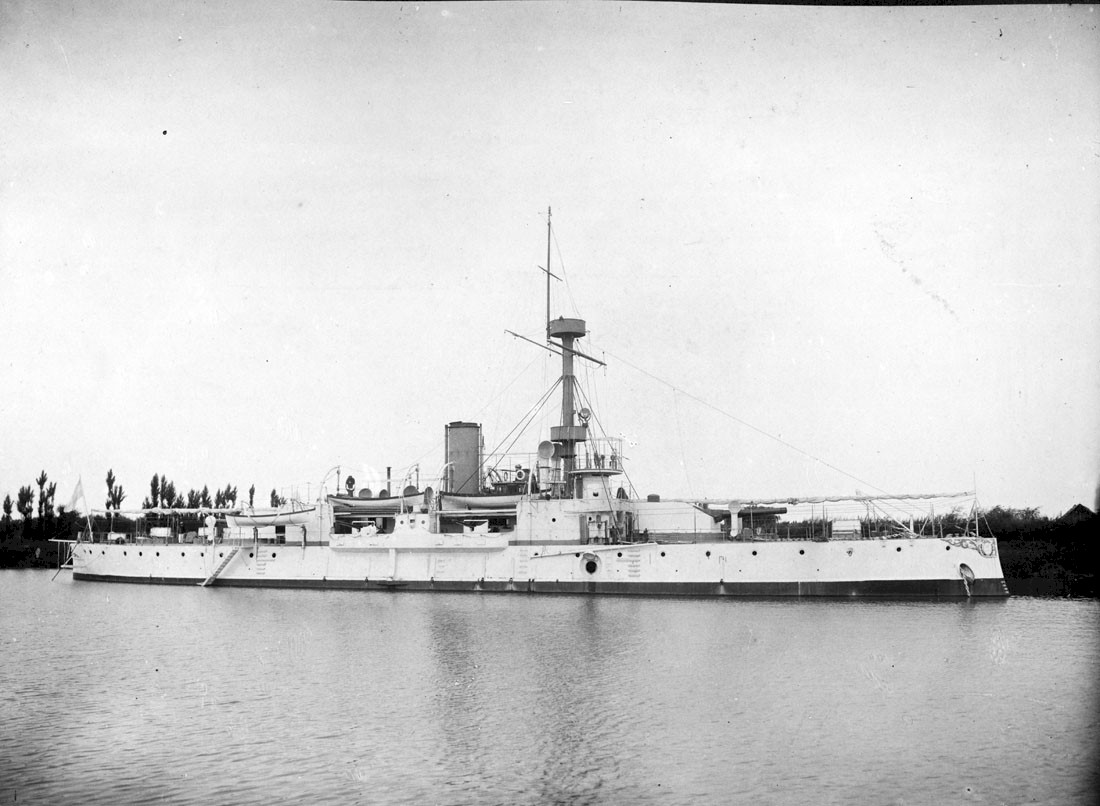
The Libertad class were two coastal battleships ordered by the Argentinian Navy in a context of extreme tension with Chile. Both were ordered from a British yard and launched in 1887, and differed in some ways. Libertad and Independencia provoked however a real sismic wave in South America. The first south american battleship was ordered by Brazil (Riachuelo) in 1882, becoming a wake up call for the USN. But the Libertad class were the first modern battleships of the Argentinian Navy, a threat on the Pacific (Brazil’s ship was in the Atlantic) and the start of a famous naval race in history, which almost ended in a full-out war with Chile and ruined both nations. After covering last year the second naval arms race, between these and Brazil, let’s dive into the origin of it all, this month and until late July.
Origins and Context to the Naval Arms Race

In South America, two nations with a large pacific facade were on the brink of war or full out war at several occasions: Chine and Argentina were freed from Spanish rule. But their position on the “Southern Cone” was likely to hinter each others and was the object of several wars:
Indeed, this decade of high tension was primarily driven by territorial disputes over control of the southern region of Patagonia and the strategic importance of sea power in the region.
Tensions had been simmering for years due to conflicting territorial claims, specifically the ownership of the Strait of Magellan and the Beagle Channel. Indeed, the Argentine and Chilean navies possessed insignificant naval forces in the 1860s. These were a colection of civilian vessels with had hoc addition of various guns. There were up to five warships in the second only. Argentina however became concerned over the newly built Imperial ambitions and significan naval program of the Brazilian Navy. The ongoing Chilean war against Spain also was a concerned as the latter were increasing considerable their own program. They were in the process to add far more capable warships in the 1870s.
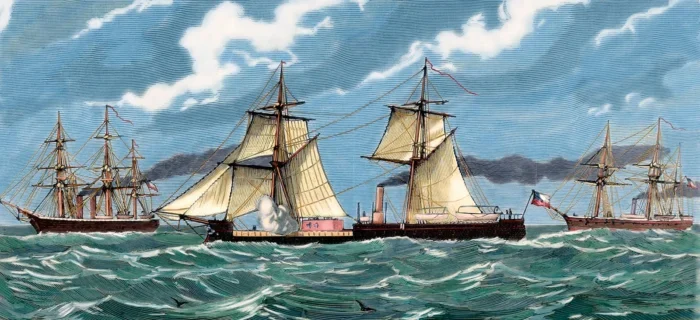
Diplomatic relations between Argentina and Chile soured at the time based on boundary claims in Patagonia and after the War of the Pacific, the Chilean government managed to retake the lead in the Americas.
The arms race intensified in the 1880s when after Brazil’s acquisition, Argentina sought to acquire modern warships from Europe to strengthen its capabilities, and under the leadership of President Julio Argentino Roca, the country was poised to retake the advantage over Chile.
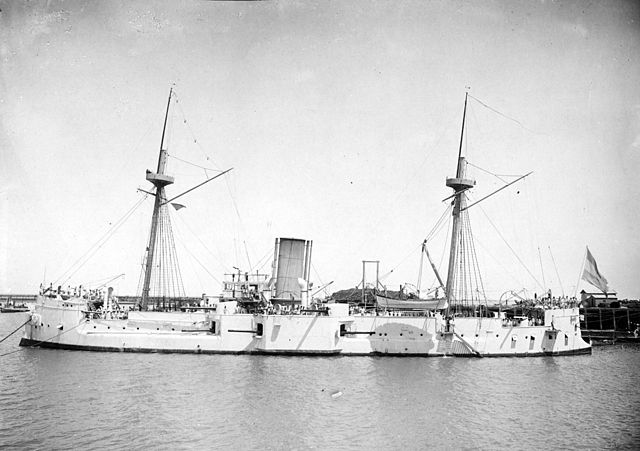
ARA Almirante Brown. Ordered before Brazil’s Riachuelo, this was a first ironclad for Argentina. A small, 14 knots, 4,200 long tons central battery ship protected by 9-inch (230 mm) plating she was armed with eight breech-loading guns, first in South America using steel armor and largest vessel in the Argentine fleet for over 15 years.
Argentina purchased the armored cruiser ARA Almirante Brown from Samuda Bros. in London in 1879 and she was launched on 6 October 1880. Thus ship really marked the start of their naval expansion. We will get to this one later, but is not cited as part of the naval race, although Chile was very much concerned but did not answered yet.
Indeed, in 1886, Argentina reinforced its effort by the purchase of a new battleship, this time a modern barbette vessel, in Britain. Launched in 1887, the Libertad, and later the Indepencia, added to the earlier and still valid Brown, this time rang bells at the Chilean Embassy and Chile, led by President José Manuel Balmaceda, responded to Argentina’s naval buildup by initiating its own massive shipbuilding program: The 1887 appropriation was for one battleship, two protected cruisers, and two torpedo gunboats, with the will to acquire new state-of-the-art vessels from Europe, such as the battleships Capitán Prat and Errazuriz, as well as armored cruisers. Since European yards were at full capacity already, both countries ordered mostly in Britain and France, until Italy became a valuable option in 1894.
So it’s really after this final announcement that naval arms race really began.
The Race’s ships
As often the case, the race started with classes of ships (coastal battleships, and then protected cruisers), which needed answer on both sides. Argentina was the first to ramp-up the game by ordering four armoured cruisers to Italy, in whih Chile tried to answer with more protected cruisers and its first armoured one (O’Higgins) and then a class of “cruiser-killer” which were modified pre-dreadnought and distant ancestors of the battlecruisers.
⚙ The naval Arms Race | |
 Armada de Argentina Armada de Argentina |  Armada de Chile Armada de Chile |
| Libertad class (BB) 1887 Veinticinco de Mayo (PC) 1890 Nueve de Julio (PC) 1891 Buenos Aires (PC) 1894 Garibaldi (AC) 1895 San Martín (AC) 1896 Pueyrredón (AC) 1897 General Belgrano (AC) 1898 Rivadavia, Moreno* (AC) 1901 |
Capitán Prat (BB*) 1887 Presidente Errázuriz (PC) 1887 Presidente Pinto (PC) 1887 Blanco Encalada (PC) 1892 Esmeralda (AC) 1894 Ministro Zenteno (PC) 1894 O'Higgins (AC) 1896 Constitución class (BB) 1901 Chacabuco (PC) 1901 |
In 1891, Argentina thus had three ironclad/battleships, Chile one, but the race started to evolve into another terrain, cruisers, as Chile was willing to wage a commerce war against Argentina and recinforced her ironclad by two protected cruisers, fast and well armed. It’s really indeed with the order of the Presidente Pinto class (also from France) following the French young school theories, that Argentina was concerned and ordered a ship fast enough to catch them in Britain, Veinticinco de Mayo (launched 1890). To what the Argentinians answered with a new program and ordered in a short span Veinticinco de Mayo (1890), Nueve de Julio (1891) and finally Buenos Aires (1894) as the Chilean in between turned to Britain to acquired really matching protected cruisers from renown naval architect William Reed, the Blanco Encalada (1892) and Esmeralda (1894) at the time, world’s largest cruiser (Rurik was the former).
In 1895 the Argentinians announced their first armoured cruisers, the Gaibaldi class, to which the Chileans answered with the O’Higgins, and as Argentina announced two more, Chile, now on the brink of war, answered by ordering to Britain two “Garibaldi-killer”, the future Swiftsure class, more pre-dreadnought than armoured cruisers, to which the Argentinians answered with the Rivadvia class.
The Pacts of May
For all this time, the arms race escalated tensions each year between the two countries, and the possibility of armed conflict loomed large. To such point, both to avoid economic collapse and preserve balance and stability in the region (Both Argentina and Chile were important exporters to Britain and the US), and international mediation efforts, particularly led by the United States and the United Kingdom, helped defuse the situation. In 1902, the dispute was settled through arbitration by Queen Victoria of the United Kingdom, who awarded control of the Strait of Magellan to Chile.
The naval arms race between Argentina and Chile in the late 19th century highlighted the strategic importance of sea power in the region and underscored the unresolved territorial disputes between the two nations. The conflict was ultimately resolved through diplomatic means, but it left a lasting impact on the relationship between Argentina and Chile.
The “Pacts of May” succeeded into lessening tensions and a quasi-war until 1904 when Brazil’s congress voted a large naval construction plan (and trigerring the second, dreadnought race).
Design of the class
Order (July 1889)
Willing to answer the recently ordered Chilean Capitan Prat, On July 24, 1889, under the presidency of Miguel Juárez Celman and the Ministry of War and Navy was Eduardo Racedo, the Argentinian staff looked in Britain for the construction of a moden barbette steel ironclad. The contract was signed the same July 1889 through the Argentinian Commission in London, a contract with the shipyard Cammell Laird, Birkenhead. The order was for the construction of a “two ships, twin-shaft, ram-equipped battleships for riverine service” (dos acorazados de espolón de doble hélice para servicio de ríos”) at a cost of £176.000. This transaction was approved in September by the Ministry.
The ships were called in Spanish “riverine battleships” according to their general caracteristics. They were not up to scale compared to Western ships but rather coastal in nature, more in line with the previous ironclad Almirante Brown, and to the Chilean Capitain Prat, rather small to European standard.
She was in effect a coastal battleship with relatively low freeboard and draught in order to perform coastal and even riverine operations were practicable. In fact this was confimed both by Argentinian records (“Riverine Battleship” or “Acorazado de Río”) while the 1902 Jane’s Fighting Ships listed her a as “Coast Service Battleship”.
Construction
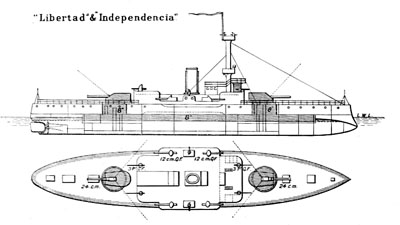
Side and top views of ARA Libertad in Brassey’s 1899 edition
The first ship was initially called Nueve de Julio. She was later renamed Libertad as new cruiser was assigned the previous name and construction was scheduled to start in 1890, launched in 1891 completed that year. After finalizing trials, in November 1892 the ship was formally accepted by the Argentine Navy under command of Captain Atilio Barilari. She departed Liverpool on December 20, 1892 and arrived at Buenos Aires on January 25, 1893.
Hull and general design
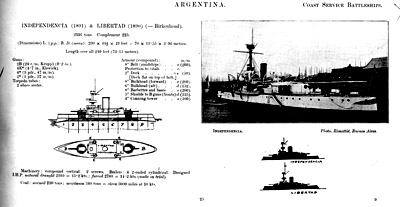 The Libertad class only measured 73.15 m (240.0 ft) or 70.10 metres (230 ft) between perpendiculars, for a beam of 13.55 m (44.5 ft) making for a ratio of 5.6/1; Her draft in comparison was low due to her riverine use, at just 3.96 m (13.0 ft). The class had a steel hull subdivided by transverse and longitudinal bulkheads, with a reinforced ram bow.
The Libertad class only measured 73.15 m (240.0 ft) or 70.10 metres (230 ft) between perpendiculars, for a beam of 13.55 m (44.5 ft) making for a ratio of 5.6/1; Her draft in comparison was low due to her riverine use, at just 3.96 m (13.0 ft). The class had a steel hull subdivided by transverse and longitudinal bulkheads, with a reinforced ram bow.
This was a rather simple ship design, with a single amidships funnel, single military mast with a protector platform and fighting top (for the 20 mm Nordenfelt). The central structure was organized around the two fore and aft main 9.4 inches Barbette Krupp guns, the forward structure supporting two tandem 47 mm guns, with a symmetrical arrangement aft. The same fore structure supported the conning tower, and the spotting deck was built above. The steering bridge was a wooden structure located aft of it, with a platform above. The four 120 mm Elwick guns were located in two amidsips positions on the weather deck. The service boats were located around the funnel as customary, as the the air intakes. The main mast was strapped at the rear of the fighting top. There was no wireless telegraphy at that time. The military mast differed on both ships.
Armour protection layout
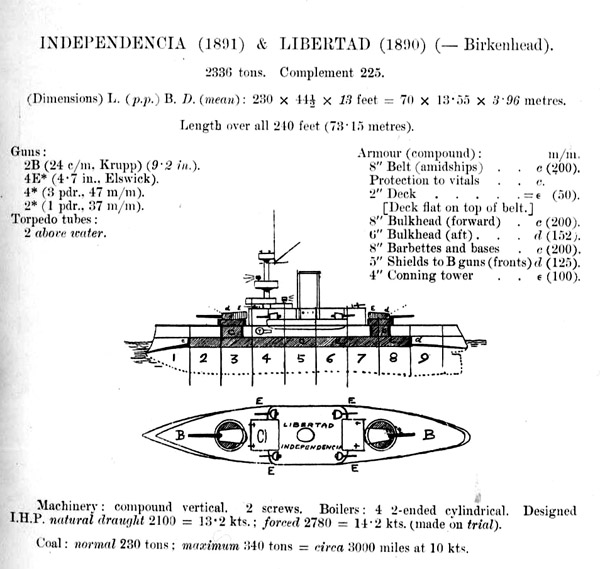
For her role, this class was reasonably well protected, to the level of her own artillery as the belt armour was slightly inferior to her main gun caliber (9 inches versus 7.9 inches), as were the barbettes.
Deck: 50 mm (2.0 in)
Belt: 200 mm (7.9 in)
Main gun shields: 125 mm (4.9 in)
Barbettes: 200 mm (7.9 in)
Conning tower: 100 mm (3.9 in)
Powerplant
Speed was coherent for the technology of this day and age and role of coastal and riverine defence ships: She had two 2 shaft four-bladed bronze propellers, driven by two Vertical Compound steam engines rated for 3,000 ihp (2,200 kW) or 2,070 kilowatts (2,780 ihp) depending on the source. They were fed by four cylindrical boilers, and they carried 340 tons coal (maximum). Top speed was thus 11 knots (13 mph; 20 km/h) on regular use, but as tested, Libertad reached a top speed of 14.2 knots (26.3 km/h; 16.3 mph) in her sea trials. Range was limited to 3,000 nautical miles at the cruise speed of 10 knots.
Armament
Main: Two Krupp 24 cm K L/35
These ships were equipped specifically with German guns (Krupp) as there was a contract already to equip the ground troops were these. These were two 24 cm (9.4 inches) with 35 caliber barrels, placed on Vavasseur mountings and protected with armoured shields. They were developed in Germany from 1888 for the coastal battleships of the contemporary Odin class in the early 1890s.
It weighted 21.5 t (23.7 short tons) for 8.4 m (27 ft 7 in) or 7.8 m (25 ft 7 in) barrel only, and fired separate bagged charge projectiles 140–215 kg (309–474 lb) HE type.
It used the Cylindro-prismatic breech block, could elevate to +25°. Rate of fire was two rounds a minute at 580–650 m/s (1,900–2,100 ft/s) velocity and max range of 13 km (8.1 mi).
Secondary: 4x 4.7 in/40 Elwick
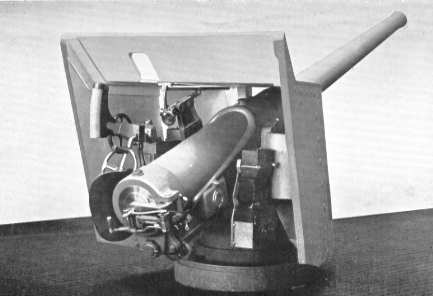
The Libertad class also had four 120 mm (4.7 in) Elswick guns, capable of faster-firing, and located alidships under shields, either side of the central structure. Arc of fire was enabled by cutouts in the structure and of around 110°. Developed from 1885 they were in short capable of 5–6 rounds per minute (1,786 fps) at 10,000 yards (9,100 m), thus close to the main guns.
Tertiary and TTs
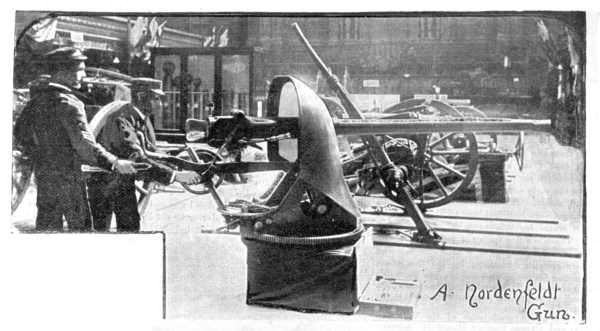
The battery was constistent for the 1880s and comprised a seot of four Swedish Nordenfelt guns: Four 47 mm (1.9 in) QF or “3-pdr”, which fired a Fixed QF 3 lb 4 oz (1.5 kg) 47-millimetre (1.850 in) HE shell. The gun used a Vertical sliding-block breech with locking wedge. mz 1,959 ft/s (597 m/s), max range 4,000 yd (3,700 m)
She also had four 25 mm (0.98 in) or 1-pdr Nordenfelt guns in the fighting top, one for each angle, unshielded. These were short-range weapons firing a 7.25 ounces (0.206 kg) solid steel bullet with brass jacket at a muzzle velocity of 1,464 feet per second (446 m/s). Rate of fire was not far from a machine-gun thanks to overhead ammunition magazines, but hand-cranked in order to evacuate the spent cartridge and load a new one by gravity.
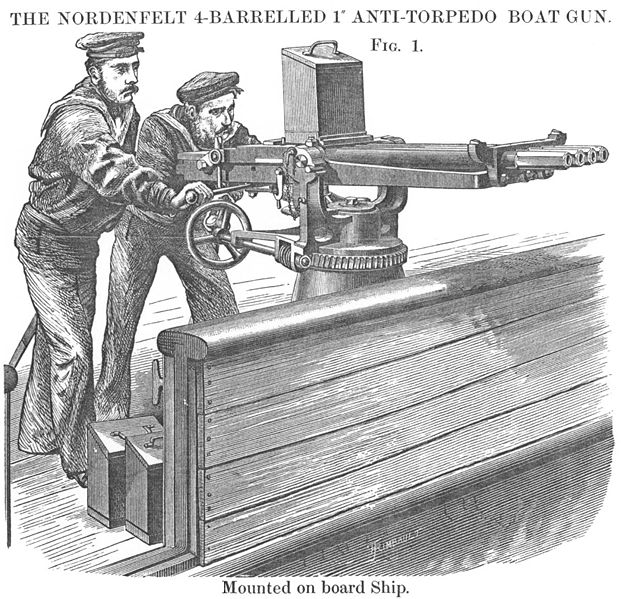
Lastly, the ships had two 457 mm (18.0 in) Whitehead torpedo tubes. These were of the standard British type; mounted into the hull in side fixed positions above the waterline.
⚙ specifications |
|
| Displacement | 2,336 tons |
| Dimensions | 73.15 x 13.55 x 3.96 m (240 x 44.5 x 13.0 ft) |
| Propulsion | 2-shaft Vertical Compound SE 3,000 ihp (2,200 kW), 4 cyl. boilers |
| Speed | 11 knots (13 mph; 20 km/h), 14.2 kts trials |
| Range | 340 tons coal (maximum), 3000 nautical miles @ 10knots |
| Armament | 2× 240mm Krupp, x4 120 mm Elswick, 4× 47 + 4× 25 mm Nordenfelt, 2× 457 mm Whitehead TTs |
| Protection | Deck 50, Belt: 200, Main gun shields 125, barbettes 200, CT 100 mm |
| Crew | 225 |
Career of the Libertad class ships
1st Division in 1894, with her sister ships and Almirante Brown. In 1905 Libertad was assigned to the hydrographic survey of the Río de la Plata, then the Training Division. In 1914 she trained crews for the new Rivadavia class dreadnought. In 1915 she was reclassified as a “coast guard ship”. In 1918–19 Libertad she was placed in reserve. Transfored in 1922–23 to a training ship and in reserve by 1924-25 she was upgraded to fuel oil and by 1927 she became a gunboat, assigned to the Gunboat Division in 1930. In December 1946 she was decommissioned, 1947 transferred to the Coast Guard as station ships for pilots in the River Plate until decomm. again in 1968.
Independencia on her side had a decisive intervention at El Espinillo, a battle in which her main cannons penetrated the armor of her rival Chilean ship Andes, putting an end to the battle
In 1895 she took part in large naval exercises on high seas with Chief of Naval Staff Captain Manuel José García-Mansilla and also in the 1902 and 1909 naval exercises. Decommissioned in 1946, stricken in 1948, by 1947-48 she became a submarine tender and base. And like her sister she was at the instruction of cadets, notably those of the new Rivadavia and Moreno and used afterwards as a lighthouse pontoon until 1968.
 ARA Libertad
ARA Libertad
After carrying out her sea trials in the Irish Sea, on November 26, 1892, the Argentine flag was hoisted while Captain Atilio Barilari assumed command for commission, and she sailed from Liverpool on December 20, bound for Buenos Aires, stopping in Las Palmas (Madeira) and San Vicente via Rio de Janeiro, reaching Buenos Aires on January 25, 1893.
During the trip four sailors died of suffocation in the torpedo locker, leading to an enquiry when back home, with Lieutenant Belisario P. Quiroga (XO) criticized about personnel recruitment. During the 1893 revolution Libertad remained mobilized under command of Captain Emilio V. Barilari, before being stationed in the Outer Road, as a sanitary ship.
The 1890-1900s
In 1894 she took part in 1st Naval Division maneuvers off Maldonado forming with Almirante Brown as flagship and Independencia.
On February 6, 1895 she joined in fleet exercizes and by April in maneuvers in the Bahía Blanca.
In October, frigate captain Hipólito Oliva assumed command and the ship returned to the training squadron, with the cruiser Nueve de Julio, Almirante Brown, Patria, Resguardo and Gaviota.
In 1896 she was placed in the 2nd Division, traveling to Brazil for a goodwill trip. In August Eduardo O’Connor took command, the ship visiting Puerto Belgrano and Puerto Madryn and Río Santiago.
In 1897 she became flagship of the Second Division, taking part in maneuvers and by October-November operated off Santa Cruz, San Sebastián Bay, Rada Tilly and Puerto Madryn. She made a training cruise to Isla Escondida, Bahía Blanca, Samborombón, and Montevideo,and back to the Río de la Plata on December 28.
In May 1898, Gregorio Aguerriberry took command and she was versed into the “Río de la Plata” Division with ARA Independencia, Almirante Brown and the transport Pampa for a cruise to the Beagle Channel and back in October participated in the Naval Review at Punta Piedras.
In November 1898, Vicente E. Montes assumed command, and ARA Libertad travelled to Ushuaia in early 1899, followed by firing tests in the Nuevo Gulf. In Buenos Aires she was placed into reserve in Rio Santiago (due to budget cuts). In 1901, captain Antonio L. Mathé took command while she was sent in drydock for her first overhaul.
In 1902, Libertad was versed to the 3rd Third Division but was operated with a skeleton crew in Río Santiago. In 1903, Lieutenant José M. Mascarello took command followed by Ernesto Anabia and the ship was assigned to the Sailor School.
In April 1904 she was in the Instruction Division and by June 1905 assigned to the Río de lo Plata Hydrographic Mission, under Ernesto Anabia. After some reserve, she was back to the Training Division, partially disarmed by 1906 and remobilized with the Instruction Division of the Río de la Plata under Julián Irizar.
In 1907 Ramón González Fernández became her new CO and by February 1908 she took the head of the Instruction Division. She made one of her last gunnery training with the cruiser Veinticinco de Mayo and went on under González Fernández in 1908 with the 3rd Division, Río de la Plata.
In 1909 under captain Carlos G. Daireaux she was reactivated for the maneuver plan in link wit the Argentine Centennial in 1910, leaving La Plata for the Huevo, Oso Marino, Thetis bays, and Le Maire strait, Ushuaia, Cape Horn, Río Gallegos and Santa Elena Bay. She later returned in Río Santiago.
By 1911 under Eduardo Mendez she received a wireless radio and the radiotelegraphic indicative “G.L.”, still in the 3rd Division, Río de la Plata. In 1912, she took part in the 3rd division maneuvers with artillery maintenance at the Zárate Marina Arsenal and went to Rio Grande do Sul to the rescue of the stranded steamship Colastiné, towed to port.
World War One
In January 1913, captain Ricardo Hermelo took command and by July she was back at the Cadet Instruction Division of the Naval Military School. In February 1914 under Carlos Somoza, she was assigned to the training of the future crews of the new battleships Moreno and Rivadavia built in the US.
In 1915 unde Eduardo Ramírez she was partially disarmed and by May reclassified as a coast guard (CO Jorge Games) and by 1916 became an auxiliary ship of the Training Division in Puerto Belgrano.
By 1917 under command of Arturo Nieva she joined the 2nd Division as auxiliary ship. In May, she was assigned to Comodoro Rivadavia to repress the oil industry worker’s strike, and was anchored at the Tierra del Fuego.
On February 19, 1918, budget cuts and lack of fuel had her disarmed and partially mothballed at Río Santiago Naval Base.
The interwar
By 1920 she she was fully reactivated and versed to the 3rd school Division. By January 1921 (Captain Pascual Brebbia) she transferred back to Argentina American Admiral G.W.Basset to Montevideo and Frederic Jesup Stimson (new Ambassador in the United States). She took part in the riverine squadron maneuvers in the Río de la Plata and Paraná. With the TBs Comodoro Py and Thorne, she sailed to Concepción del Uruguay for a sanitary blockade off Uruguay during a mass epidemic.
In August, she hosted the Machinists school. By December she took aboard cadets of the Naval School for a summer cruise to Puerto Madryn. In April 1922 became her new CO while she made a training trip to the South.
As the Argentine Navy made a raid to link Buenos Aires with Puerto Belgrano Naval Base she was detached as a support ship in Claromecó.
She later helped the steamer Trifussis, towed to port, and attended the national holidays of Uruguay. In 1924-1926 she remained in Río Santiago without commander and in drydock for her second and last major overhaul, seeing her boilers changed for oil-buning ones and by 1927 she made her sea trials under command of José M. Garibaldi, redesignated as a gunboat.
In 1928-1929 she underwent a new overhaul for her hull and structure and became flagship of the south coast Instruction Division with ARA Independencia, assisted by the fleet oiler Ministro Ezcurra when departing for a cruise off Ushuaia for the winter.
In 1930 she was back in Rio Santiago, 3rd Division under Pedro Florido and Gonzalo de Bustamante in 1931 for the gunnery school Division, which with ARA Independencia, Paraná and Rosario, making cruisers in inland rivers.
She was used to carry political prisoners to Ushuaia and stayed there until March 1932 until relieved. She again brought her guns as deterrence at Comodoro Rivadavia during another oilfield workers’s strike, and then at Rosario.
In February 1933, she transferred detained strikers to Ushuaia, passed Le Maire Strait and Isla de los Estados and was assigned as base ship and tender for Argentinian submersibles until replaced by General Belgrano. She was partially inactuvated in 1934 at Río Santiago Naval Base, gunnery schoo division. She took part in the 50th anniversary of Ushuaia base.
In 1935 she was cruising for the rivering squadron under Raúl Aliaga but was sent to Porto Alegre for the centennial of the War.
With ARA Bathurst in 1936 she departed for a cadets cruise until late 1937, and back to the Rivering Gunboat Division.
By 1938 this was repeated and by May she took part in the Revolution celebrations in San Nicolás de los Arroyos, followed by fleet exercises.
World War Two
At the end of January 1939, Commander Manuel A. Pardal assumed command of the ship, and by December 17, 1939, he recorded the sighting of KMS Admiral Spee with her flag hoisted high, leaving the port of Montevideo and later the large column of smoke and two large explosions at her stern as she was scuttled. Libertad then approached to assess the damage, as well as other ships from Montevideo.
In 1940, under captain Francisco Álvarez Colodrero she was sent to San Nicolás for the anniversary of the battle of Vuelta de Obligado.
In August 1941 under captain Vicente Palumbo she took part in the Uruguayan national festivities in montevideo. In September she escorted ARA Drummond with Independencia, hosting Vice President Ramón S. Castillo to the anniversary of the San Nicolás Agreement.
From 1942 to 1946, she was flagship of the Riverine Gunboats Squadron, operating in La Plata and Paraná.
By December 16, 1946 she was stricken from the Navy’s list, and by 1947 transferred to the Argentine Naval Prefecture as stationary ship for the coast guard until 1968, when she was sold for BU.
 ARA Independencia
ARA Independencia
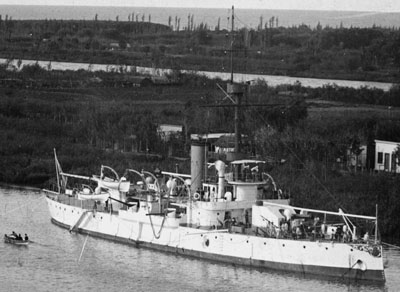
ARA Independencia was laid down in March 15, 1890, launched by February 26, 1891 and commissioned on March 5, 1892. She had been built by the same yard, Laid Bros. of Birkenhead at a cost 176,000 pounds sterling. She was well advanced for her protection and had modern breech-loading rifled Krupp guns, Armstrong rapid-fire secondaries and proven Maxim-Nordenfelt light guns. Those on the fighting top were removable to be used as support for landing operations. Her armor made of compound steel was also seen as quite modern for Argentina.
On April 7, 1893, her crew came aboard and she was inaugurated by commander Captain D. Edelmiro Correa, setting sail on June 29 for Buenos Aires from Liverpool via Madeira (Cape Verde) and Rio de Janeiro, arrving on July 31, 1893. She was anchored at Río de la Plata and by August had armed personnel sent ashore to restore order.
On September 27, she recoaled and was sent to Rosario with the TB ARA Espora, trying to catch the rebel ship “Los Andes” turned against federal government. The Espora was in the vanguard to try to find the rebel ship and Captain D. Eduardo Muscari embaked to take command of “Los Andes”, once captured, but it took a naval battle, the only one of this ship.
Battle of Espinillo
On September 27, Rosario was spotted at 11:00 a.m. anchored to the N.W. of Martín García and waiting for the TB Espora to deliver a document. Espora ran aground due to an oversight of the pilot, at Las Palmas. Gaviota also arrived and with Bermejo, working to get Espora out of her stranding. ARA Independencia went on without her and dropped anchored by night at “La Paloma” joined later by Espora. On the 29th, at 10:20 a.m. Espora on the vanguard spotted “Los Andes” stranded at Espinillo bank, north of the Barranca del Rosario, assisted by the small steamer Victoria R. Given her draft, ARA Independencia was at a disadvantage, and could not close on “Los Andes” on the river. At 11:25 a.m. “Los Andes” opened fire on Espora at 4,000 m., the first salvo ending 20 meters from her bow. This was answered by Espora’s main 75 mm guns.
“Los Andes” fired two more salvos on Espora, while ARA Independencia cautiously closed in. When arrived at 4,000 m from “Los Andes” she opened fire with her main 240 mm cannons forward and went on fiting fir the newt 50 minutes, exchanging salvos with Los Andes including her secondary guns and light artillery, but soon on the shore, a flying battery and armed people started to also fire at the two government (Loyalist) ships. At 12:32 p.m. order of cease fire was given since “Los Andes” took refuge among foreign ships, apparently badly damaged.
At 9:30 p.m. the following day, the rebel ship sent Frigate Lieutenant D. Gerardo Valotta for a parley aboard the loyalist battleship, and Captain Correa answered by an ultimatum of two hours to hand over the ship, or be shelled until surrender.
The rebels requested an extension which was granted and at 01:30 a.m. April 30th, ARA Independencia fired a warning shot to which the ship surrendered. One of her 240 mm hit had flooded her, and this was not well controlled, the ship in danger of capsizing. Thus, captain Correa sent a crew led by Captain Muscari, dispatched to operate bilge pumps and try to save the ship; During this fight, ARA Independencia suffered no hit except for a perforation from a machine gun projectile, or glass breakage caused by the concussion of her own heavy cannons firing.
After the fight was over, the battleship was placed under overall command of Government Force’s General Roca, who determined the port to be blockaded and ordered to seize two steamers trying to leave it. Commander Correa sent a 50 armed men landing party (and took its lead) with the commanders Muscari and García ashore to receive the surrender of the rebel city of Rosario at the Police Headquarters, ending the revolution.
ARA Independencia in 1894-1914
In 1894, until May the battleship stayed in Rosario and was back in Buenos Aires by June. Her CO, Frigate Captain D. Edelmiro Correa stayed at his post while she ship is conformed in the 1st Division, and she sailed off Maldonado for the winter manoeuvers. By August 1894 she entered Montevideo for the Uruguayan national holidays.
In 1895, from February to April she took part in various drills in the Bahía Blanca area until Correa is replaced by D. Luis Barraza. She became flagship of the Chief of the General Staff, D. Manuel José García Mansilla.
In 1896 she integrated one of the newly created two divisions on June 24, in the 2nd, stationed in the Río de la Plata. In Novembe she headed for Golfo Nuevo for gunnery drilling off Madryn. In
1897 (March to July) she stayed off Montevideo. In August she became flagship, 2nd Division with ARA Libertad, Patria and the the newly commissioned Garibaldi. From October to November, training cruises brought them between Puerto Belgrano, San Sebastián, Santa Cruz, Bada Tillv and Madryn, and then to Isla Escondida, Bahía Blanca, Samborombón and Montevideo, back to Río Santiago.
1898 saw her training at home for the first half of the year, and naval maneuvers in October, and later the great naval review of Punta Piedras, 7th ship, first column. Later she remained for 80 consecutive days at sea for an expedition to the Beagle channel and spent the rest of the year at the Buenos Aires roadstead.
In 1899 she remained in the Río de la Plata Division under Captain Díaz. She was partially deactivated due to budget cuts except a trip she made to Ushuaia in February-March 1899.
January-March 1900 saw her in quarantine service in the Buenos Aires roadstead, her new commander being D. Belisario Quiroga before she returned in half-reserve in Río Santiago.
By 1901 she only change captain, to D. Luis E. Calderón. being semi-decommissioned at Río Santiago Base. In 1902 she is reintergrated in the 3rd Division seeing the “Pacts of May” signed between Cile, Argentina, UK and the USA to end the naval arms race. As a result in March she is placed in reduced commission with a skeleton crew in Río Santiago under Captain Calderón.
No change for 1903 but by 1904 the Instruction Division was created in April and she integrated it, carrying out training navigations through the Río de la Plata under captain D. Julián Irizar and later D. Horacio Thwaites. By 1905 she started various hydrographic missions at the mouth of the Río de la Plata, to update the charts. In November D. José Quiroga Finque taked command.
In 1906 hydrographic tasks went on and by August she rejoins the Instruction Division until December for exercises and combat drills in the Río de la Plata under command of Juan Peffabet, then D. José Moneta. She is replaced in 1907 in reduced commission and by January 1907 is sent to Arsenal del Río de la Plata in reserve until March, for the gunnery school cadets. In August she is sent to Puerto Belgrano at the gunnery school. In February 1908 she returned to the 3rd Division in the Río de la Plata to train cadets of the Sailor Apprentice School, and procuring river navigation training under command of D. Bernardo Meroño.
In 1909 she returns to the 3rd division in the Río de la Plata until Moreno Vera takes command and by December D. Guillermo Jurgensen.
By 1910 she tooks part in the May Centennial with the 3rd Division and participates in naval maneuvers, making port calls at La Plata, Bahía Gilí, Cabo Blanco, Le Maire, Ushuaia, Cape Horn, San Julián, Bahía Escondida, Rada La Plata ending the centennial Naval Review at Río Santiago, until D. Pedro Padilla took command.
In 1911 she has been equipped with wireless telegraphy and is assigned the indicative “G.I.”. Florencio Donovan became her new captain, and she remains in Río de la Plata, in semi-disarmed conditions except for two months as sanitary police ship in Río de la Plata.
In 1912 she returned for drills with the 3rd Division until December when Donoivan is replaced by Alberto Moreno. She made a gunnery drill off Zarate and took part in this year’s Bore Shooting Championship. In 1913 she returns to the 3rd Division, with a small training staff.
ARA Independencia In WW1
By 1914 she underwent her first major drydock overhaul at the Arsenal of Río Santiago under command of Manuel Fernández Oro, until the end of the year. By December Captain Nelson Page is appointed commander and in 1915 and she remaieds in Río Santiago until March, making sea trials in the Río de la Plata wheras D. Manuel Trueba is appointed and she joined the active fleet as an “auxiliary ship” of the Instruction Division, operating until the end of the year in the waters of Puerto Belgrano and redesignated later as Coast Guard ship.
In 1916 she went on with the Training Division off Puerto Belgrano, during which Commander D. Vicente Cabello taked command and by August Teodoro Caillet-Bois. She was at Buenos Aires for the July Centennial. In late 1917 Captain Caillet-Bois is replaced by D. Julio Ayala Torales. Next the ship is sent for another Hydrography mission, a srie of surveys until April in the Golfo Nuevo.
By 1918 she stays in hydrographic service in the Golfo Nuevo area, looking for anchorages for larger ships in Madryn, Pirámides, Cracker Bay and Punta Ninfas and updated nautical charts.
ARA Independencia In the interwar
By 1919 her mission ended under command of Frigate D. Carlos A. Braña and by February she was sent to Puerto Belgrano gunnery school, semi-inactivated, and leter returned for hydrographic works, to update maps for San Jorge and San José bays.
In 1920 she is in semi-reserve at Rio Santiago and underwent another overhaul, by June is she is transferred to the machinists school. In 1921 she is retransferred to the 3rd Division in Río de la Plata under command of T. Méndez Saravia. In January she departed with the school ships of the 3rd division dedicated to cadet training, and by May, Dalmiro Sáenz taked command.
In 1922 the 3rd Division is discarded, and Independencia is reclassified as Coast Guard under command of Juan Ezquerra, assigned to the School Ships Division with trainees from the Machinist School. By October Aquiles Valarche taked command as she starts training trips through La Plata and Paraná rivers.
In 1923 she is placed in semi-reserve at Río Santiago, under command of Guillermo Coelho. The next year she is placed under the authorities of the Río de la Plata Arsenal for anither overhaul, changing of boilers (new oil-fired ones) and a general modernization throughout the year. This ends in December 1926 followed by sea trials and she returned to the Instruction Division under command of Ricardo Vago.
In 1927 she is attached to the Naval Military School and by February-April, carries out an inspection commission of the southern naval facilities to San Julián with the Junior Staff Schools aboard. She went to Concepción del Uruguay, Rosario, Zarate for artillery drills and by november in San Matías for hydrographic work training. In December she is reclassified as Gunboat.
In 1928 she stays with the instruction Division, in Rosario with the gunboats Rosario and Paraná sent to quell the port strike. She is sent next to Buenos Aires to take aboatdthe remains of D. Vicente A. Echeverría to the city of Santa Fe, for burial in his native land. In December, she is part of a new Instruction Division as flagship, and starts a summer cruise with cadets under command of Jorge Siches and later Martín Arana.
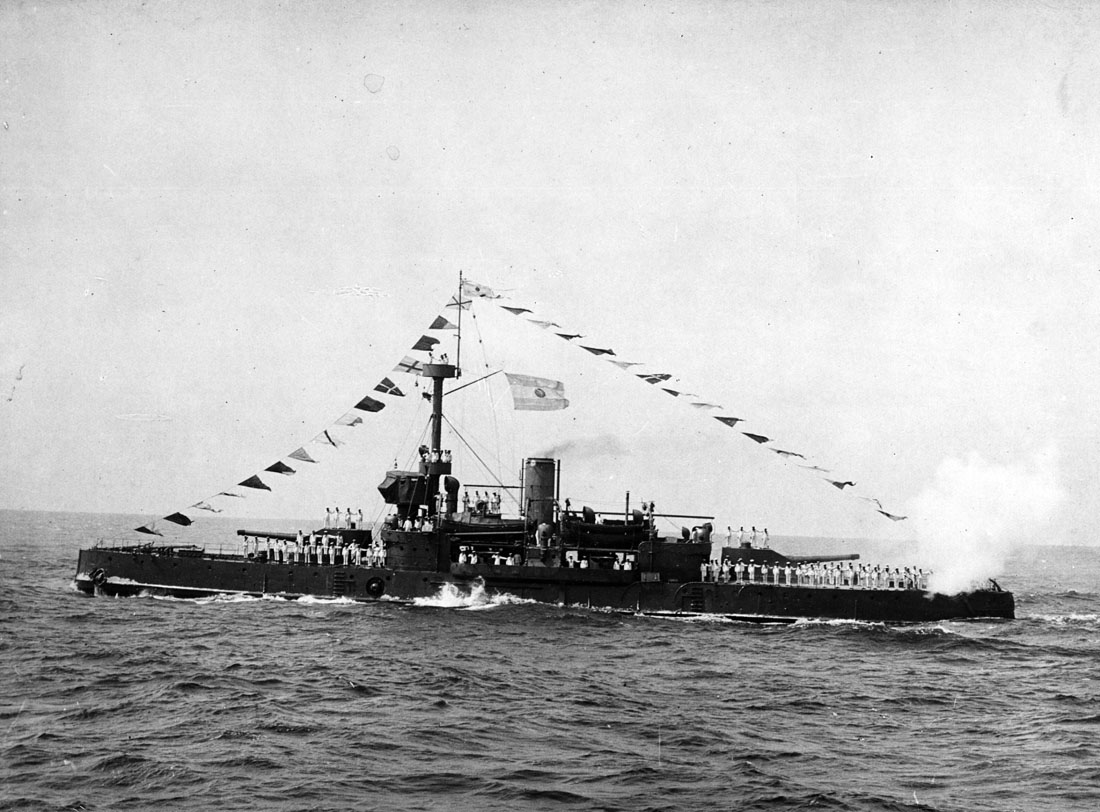
In the interwar, date unknown. Notice her dark hrey livery and newly built fully enclosed bridge over the CT platform.
In 1929 she made a cruise in La Plata, arriving at Cabo Corrientes after a 90-day riverine navigation. She was placed in semi-reserve until November until a cruise to Puerto Madryn with cadets under Martín Arana and Mario Fincati, then Arturo Zimmermann and by 1930 made a cruise to Ushuai, assisting in the rescue of the stranded steamer Monte Cervantes. Later she returned to the instruction division with Libertad, Rosario and Paraná under command of Torcuato Monti, Luis E. Cartasso and Secundino Odriozola.
In 1931 Adolfo P. Garnaud takes commad and she is sent to the island Martín García in reinforced surveillance of political prisoners there. She later made a trip between Buenos Aires and Ushuaia with the division. In 1932 she is placed in semi-reserved under Carlos A. Moreno Vera until 1935, in overhaul the previous year.
By 1936 under Francisco Clariza she is transferred to the gunnery Division, river squadron in the Río de la Plata an Paraná. Ernesto Basílico taked command and in 1937 Captain Clariza, then Ernesto Pineyro and by 1938 Ruperto Parodi Lascano. On May 25 she is sent to Concepción del Uruguay’s national holidays. She trained off Puerto Belgrano.
ARA Independencia in WW2
By 1939 Américo Cáceres taked command and she is sent on May 25 to Santa Fe for the national holidays. In 1940 Pedro V. Ghirimoldi taked commmand and she went on trining with the Gunboat Division. By 1941 she is sent to Montevideo for the Uruguayan national festivities on August 22-27. In September with Libertad and the new escorts Drummond she is sent to to San Nicolás, taking aboard Vice President Dr. Ramón Castillo there for celebrations. José Schwarz later taked command and in 1942 she went on training with the gunnery division, and taked part in Montevideo’s Uruguayan national holidays in August. In 1943 José L. Echavarren taked command and after the revolution of June 4, 1943, D. Luis Harriaguc, then Carlos Rivero de Olazábal, still in the river squadron.
In 1944 no change, she is based in Río de la Plata, Rueños Aires, north Dock and Río Santiago base and by 1945 Pablo Caillet-Rois, seeing little activity.
Postwar years
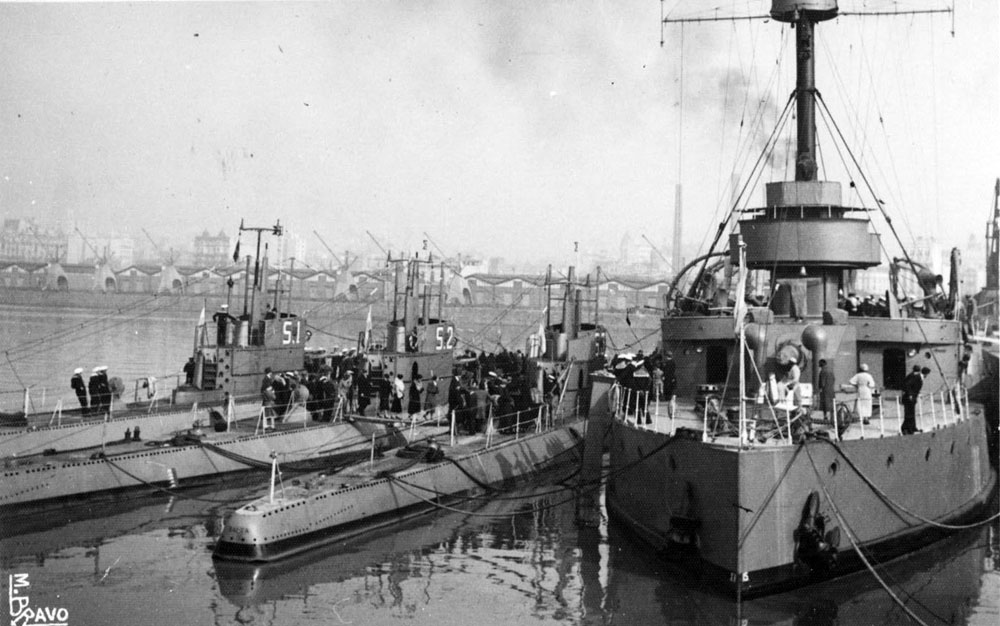
By January 1946 Edgardo Izquierdo Brown takes command followed by Ramón Casanova and she sees no activity upon her general condition, a report advising his radiation. This is done by the Decree of December 16, 1946 but no immediately fulfilled. In 1947 D. Néstor P. Gabrielli taked command and it is decided to have her used as submarine base in Mar del Plata. On December 10, José Amor took command for her new role in in Mar del Plata.
From 1948 to 1951 under command of Captain Amor, she remained as mother ship for submarines, with their crews aboard for their stay in port, and immediate logistical support, and is is requested later to use her as a stationary lighthouse pontoon on an important roadstead for the safety of trade. She had her hull painted cherry red with a legend in white and the entire superstructure also repaitind in white, including spars and crow’s nest. She served in this new condition from 1949 to 1957, replaced Liberted as landfall Pontoon. During a strong storm in 1961 she dragged her anchor and was damaged. She was later repaired it at Naval Arsenal and returned to service. In 1964 she was collided by the Swedish oil tanker Hoeg, and nearly capsized. She was repaired again and returned to service as a pontoon. By 1968 she was finally sold for scrap to Ayasa SA, delivered on 12.18.1969.
Read More
Books
Conway’s all the world’s fighting ships 1865-1905
Las maniobras Navales de 1902. La evolución de las tácticas de la Armada Argentina ante el conflicto con Chile, 1881-1902. Boletín del Centro Naval 824, 2009.
Caillet-Bois, Teodoro (1944). Historia Naval Argentina. Buenos Aires, Imprenta López.
Arguindeguy, Pablo E.; Rodríguez, Horacio (1999). Buques de la Armada Argentina 1852-1899 sus comandos y operaciones. Buenos Aires: Instituto Nacional Browniano.
Arguindeguy, Pablo (1972). Apuntes sobre los buques de la Armada Argentina (1810-1970). Comando en Jefe de la Armada.
Burzio, Humberto (1960). Armada Nacional, Secretaria de Estado de Marina.
Piccirilli, Ricardo; Gianello, Leoncio (1963). Biografías navales, Secretaría de Estado de Marina.
Burzaco, Ricardo and Patricio Ortíz. Acorazados y Cruceros de la Armada Argentina, 1881–1982. Eugenio B. Ediciones 1997
Memoria de Marina; OO. GG.; OO. DD.; Circulares; A. G .M.: años 1892/1969.
“La artillería del «Libertad» e «Independencia». Peffabet. B. C. N. Tomo 11.
Links
Chilean_naval_arms_race
en.wikipedia.org/ ARA_Libertad
es.wikipedia.org ARA_Libertad_(1892)
es.wikipedia.org ARA_Independencia_(1893)
histarmar.com.ar/ Independencia
argentina.gob.ar/armada
Model Kits
None found !
3D
None found!


 Latest Facebook Entry -
Latest Facebook Entry -  X(Tweeter) Naval Encyclopedia's deck archive
X(Tweeter) Naval Encyclopedia's deck archive Instagram (@navalencyc)
Instagram (@navalencyc)





 French Navy
French Navy Royal Navy
Royal Navy Russian Navy
Russian Navy Armada Espanola
Armada Espanola Austrian Navy
Austrian Navy K.u.K. Kriegsmarine
K.u.K. Kriegsmarine Dansk Marine
Dansk Marine Nautiko Hellenon
Nautiko Hellenon Koninklije Marine 1870
Koninklije Marine 1870 Marinha do Brasil
Marinha do Brasil Osmanlı Donanması
Osmanlı Donanması Marina Do Peru
Marina Do Peru Marinha do Portugal
Marinha do Portugal Regia Marina 1870
Regia Marina 1870 Nihhon Kaigun 1870
Nihhon Kaigun 1870 Preußische Marine 1870
Preußische Marine 1870 Russkiy Flot 1870
Russkiy Flot 1870 Svenska marinen
Svenska marinen Søværnet
Søværnet Union Navy
Union Navy Confederate Navy
Confederate Navy Armada de Argentina
Armada de Argentina Imperial Chinese Navy
Imperial Chinese Navy Marinha do Portugal
Marinha do Portugal Mexico
Mexico Kaiserliche Marine
Kaiserliche Marine 1898 US Navy
1898 US Navy Sovietskiy Flot
Sovietskiy Flot Royal Canadian Navy
Royal Canadian Navy Royal Australian Navy
Royal Australian Navy RNZN Fleet
RNZN Fleet Chinese Navy 1937
Chinese Navy 1937 Kriegsmarine
Kriegsmarine Chilean Navy
Chilean Navy Danish Navy
Danish Navy Finnish Navy
Finnish Navy Hellenic Navy
Hellenic Navy Polish Navy
Polish Navy Romanian Navy
Romanian Navy Turkish Navy
Turkish Navy Royal Yugoslav Navy
Royal Yugoslav Navy Royal Thai Navy
Royal Thai Navy Minor Navies
Minor Navies Albania
Albania Austria
Austria Belgium
Belgium Columbia
Columbia Costa Rica
Costa Rica Cuba
Cuba Czechoslovakia
Czechoslovakia Dominican Republic
Dominican Republic Haiti
Haiti Hungary
Hungary Honduras
Honduras Estonia
Estonia Iceland
Iceland Eire
Eire Equador
Equador Iran
Iran Iraq
Iraq Latvia
Latvia Liberia
Liberia Lithuania
Lithuania Mandchukuo
Mandchukuo Morocco
Morocco Nicaragua
Nicaragua Persia
Persia San Salvador
San Salvador Sarawak
Sarawak Uruguay
Uruguay Venezuela
Venezuela Zanzibar
Zanzibar Warsaw Pact Navies
Warsaw Pact Navies Bulgaria
Bulgaria Hungary
Hungary

 Bundesmarine
Bundesmarine Dutch Navy
Dutch Navy Hellenic Navy
Hellenic Navy Marina Militare
Marina Militare Yugoslav Navy
Yugoslav Navy Chinese Navy
Chinese Navy Indian Navy
Indian Navy Indonesian Navy
Indonesian Navy JMSDF
JMSDF North Korean Navy
North Korean Navy Pakistani Navy
Pakistani Navy Philippines Navy
Philippines Navy ROKN
ROKN Rep. of Singapore Navy
Rep. of Singapore Navy Taiwanese Navy
Taiwanese Navy IDF Navy
IDF Navy Saudi Navy
Saudi Navy Royal New Zealand Navy
Royal New Zealand Navy Egyptian Navy
Egyptian Navy South African Navy
South African Navy






























 Ukrainian Navy
Ukrainian Navy dbodesign
dbodesign